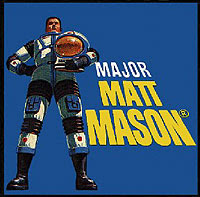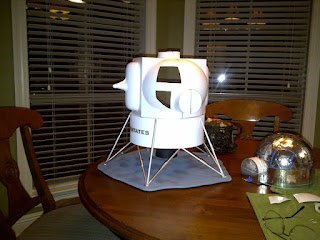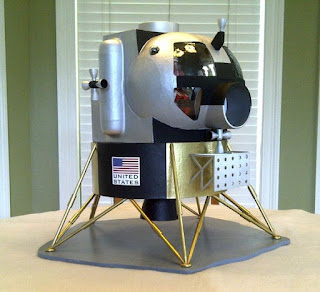 |
| Pat LeBlanc's Early LEM Custom |
Submitted by Pat LeBlanc on 2018.08.18
This is one of those projects where I regret not acquiring one from Pat. His exploration into designing an MMM-scale "Early LEM" - a design proposed by Grumman for NASA prior to the actual Lunar Module design. It seems very fitting as a lander for Matt Mason and crew. 20" in diameter, 17" tall.
Pat Writes:
2018.07.20
The final piece is the aft equipment bay (small box behind the midsection). This will be vacuum formed in one piece. Access to the interior of the crew cabin will be from the back (similar to the Madelman lander). The interior will include chairs and an instrument panel. I will post more pictures as the project progresses.
Here is a picture of a test pull of the port half of the ascent stage sitting on top of the descent stage with an astronaut for scale. I haven't cut the panels out for the windows yet.
The ascent stage is reproduced by combining simple shapes like hemispheres, cylinders and rectangles. The crew cabin and midsection will be vacuum formed in two pieces (port and starboard) and joined down the middle.
The descent stage is formed from sheet styrene wrapped around two fiber board disks. The legs are 1/4" wooden dowels. The descent engine bell is vacuum formed.
At 1/12 scale the LEM is 17" tall compared to 22" tall for the LM. The diameter (at the footpads) of the LEM is 19" compared to 31" for the LM. The smaller size of the LEM would drastically reduce shipping costs.
Over the years, people have requested dimensioned plans but since this was a one-time effort, I hadn't made any. As I've gained experience with vacuum forming, I've wanted to try to build a simplified version that could be easily reproduced. The picture above is an early Grumman concept for the Lunar Excursion Module.
2018.07.24
LEM progress report: completed starboard midsection master and made first attempt at vac-forming. Not completely successful but not bad for a first try. Cut the windows out. Here it is taped to the port half.
Here is another progress shot of the port side of the crew cabin/midsection. I wasn't satisfied with the first iteration. If you look at the earlier picture, the sphere of the crew cabin sticks out of the front a wider midsection. When I started to lay out the thrusters, I realized this was not going to work. I reduced the width of the midsection so that the sphere sticks out of the front and the side of the midsection. This revision is much more faithful to the pictures.
Here is another shot of the trim med port half.
2018.08.11
Trial assembly of the port & starboard halves of the crew cabin/midsection (with a couple of visitors).
Using the sphere of the crew cabin, I thermal formed a thin sheet of Plexiglas to make the four windows of the LEM.
2018.08.18
For those of you who are interested in "how the sausage gets made", this is a picture of the vac-form masters created for the LEM project: the starboard half of the Midsection, the Aft Equipment Bay, the port half of the Midsection, the Crew Cabin (used to make the port and starboard halves plus the thermal-formed Plexiglas windows), the fuel tank (attaches to the starboard and port halves of the Midsection), the RCS thruster, the descent engine and the top docking tunnel (attaches to the starboard and port halves of the Midsection).
The styrene is 1 mm before vacuum forming. I used 16" x 16" sheets for the large pieces so they the plastic does not get stretched and thinned out. The spherical parts are pretty tough. The edges of the flat opening where the AEB meets the Midsection have been reinforced with pieces of Corflute (plastic sign material).
The styrene is 1 mm before vacuum forming. I used 16" x 16" sheets for the large pieces so they the plastic does not get stretched and thinned out. The spherical parts are pretty tough. The edges of the flat opening where the AEB meets the Midsection have been reinforced with pieces of Corflute (plastic sign material).
2018.08.18
The Aft Equipment Bay (AEB) has been vac-formed. This will be removable. It is the last large vac-formed piece (there will be 16 thrusters for the RCS quads).
2018.08.25
Early LEM progress report: painted crew cabin/midsection, installed RCS thrusters, four large panel windows and two small bubble windows.
Started "Matternizing". Added seat decals that won't react with MMM rubber. painted removable aft equipment bay.
Finished interior with swiveling pilots' seats, decal of control panel between the front windows and smaller decals of switches to either side of the pilots.
2018.08.26
Almost done (I need to get to a better printer for the last few decals on the back). The part count is as follows:
20 vac-formed styrene
41 hardwood
12 Corflute bracing
8 magnets
7 sheet Plexiglas
6 thermal-formed Plexiglas
3 fiber board
2 shipping tube
2 tube caps
2 PVC pipe
1 thermal-formed styrene
1 sheet styrene
A few more stats. It took 82 days (just under 3 months) to build the tools and masters.and put the first "Early LEM" together. As a comparison, it took 5 months 15 years ago to make a one off of the final version of the Lunar Module. Now that I've made this first one, I can make a copy in about 3 weeks. If anyone is interested, I will make these on a first come,first served basis. Price is $200 plus actual shipping (estimated to be less than $50 to most parts of the US). Like my other customs, I will label each with the production number and date.
2018.09.08
Here are some orthographic views of the Early LEM:
2018.09.09
Frank May 's Early LEM (production no. 2) is complete and ready for packing up. (that's his on the left, my no. 1 on the right). Construction of Robert Rosenberg 's no. 3 is underway. Anybody interested in no. 4?
2019.03.23
With Robert Rosenberg's X-RV on the way (it should be there Monday), I've started on two more X-RV's and another LEM (for Robert). These pictures represent about 5 hours of vac-forming for the large components made from 16"x16" pieces of sheet styrene. The descent stage is also coming along nicely.
2019.03.24
This represents about 2.5 hours of vac-forming for the medium components made from 12"x12" pieces of sheet styrene. (duplicate images of above)
2019.03.31
Making progress on the LEM and the X-RV's.
2019.04.07
Progress shot of the Early LEM for Robert Rosenberg:
2019.04.14
Another progress shot of Robert's Early LEM. Ascent stage is painted and striped with panel windows installed. Been working on the small pieces (thrusters and porch).
2019.04.21
Progress on Robert's early LEM: thrusters installed, decals applied.
2019.05.19
Getting the styrene sheets ready for the Early LEM I'll be building for Karl Tate.
2019.05.26
Here is a progress shot of the Early LEM build for Karl Tate.
2019.06.03
Getting close on the Early LEM for Karl Tate.
Before packing up the Early LEM for Karl Tate, Doug Davis decided to take a spin around it and Jeff Long (in the Moon Suit) with the Astro Trac:
2019.07.14
Here is progress shot of the customized early LEM I'm building for Scott Estel. The paint job will be closer to the final design with a gold & black descent stage and a silver and black ascent stage. If "Barry" would give me a break, I could paint the ascent stage. Still hoping to have it finished by July 20.
2019.07.20
For the 50th anniversary of the 1st moon landing , here is the customized Early LEM built for Scott Estel.
2019.08.07
In case anyone else is interested, here are pictures of the various versions of the Early LEM and a link to a video with other MMM items for scale.
You can reach Pat LeBlanc on Facebook, he's also an active member of the MAJOR MATT MASON Facebook group.
Should anybody reading this have any similar information, additions or corrections, then we would very much appreciate hearing about them.
All Mattel images and captions are copyright Mattel and used without permission. All other content, including images and editorial, is Copyright © 1997-2024 John Eaton and/or contributors unless otherwise stated. If there are any comments or objections, please contact John Eaton.





















































No comments:
Post a Comment